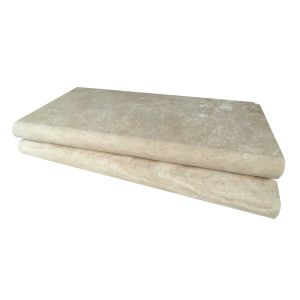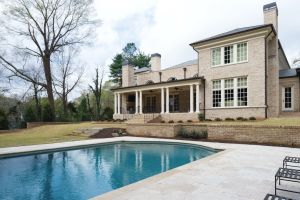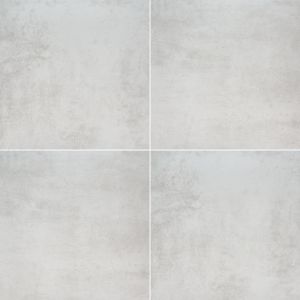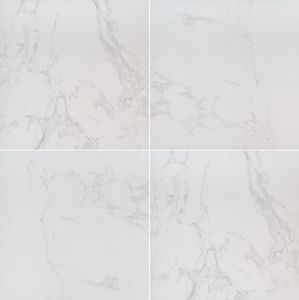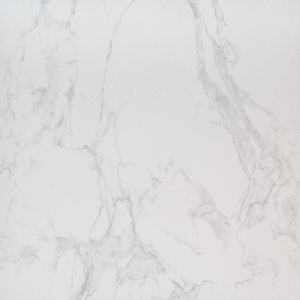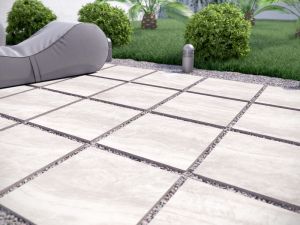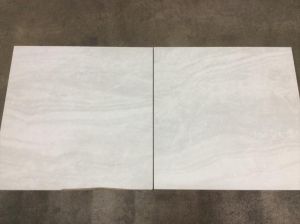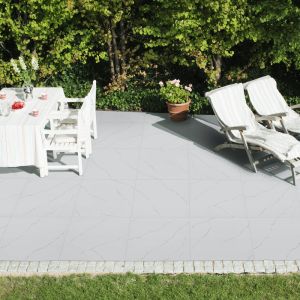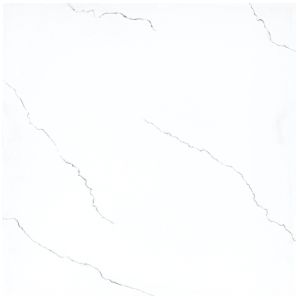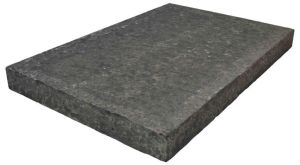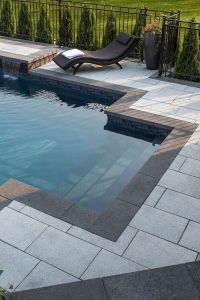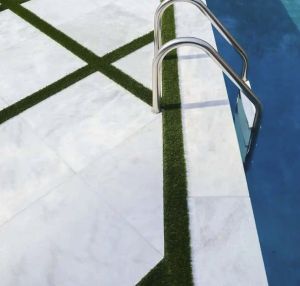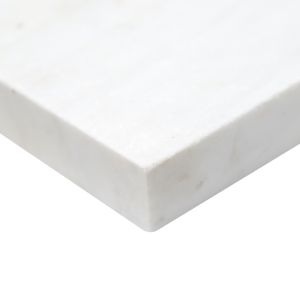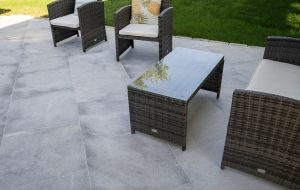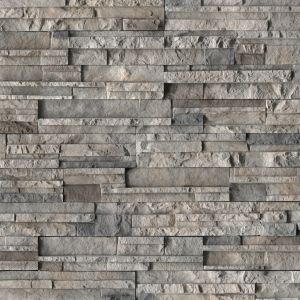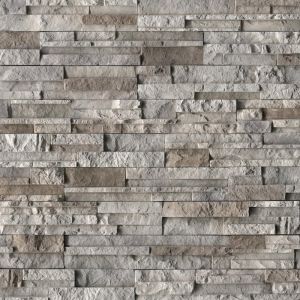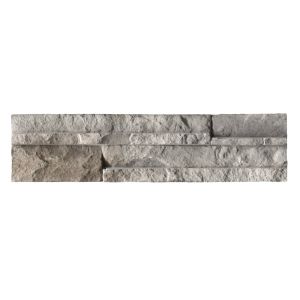This website uses cookies to ensure you get the best experience on our website. Read more
NATURAL STONE INDUSTRY GLOSSARY
- ALUMINUM STEARATE
- Anti-settling agents in paint, varnish, water repellents and cement for pigments and other colorings.
- AMBIENT TEMPERATURE
- Environment temperature
- ANHYDROUS
- A compound substance containing no water molecules.
- ANORTHOSITE
- Igneous rock characterized by large matrix grains that is dark in color.
- ANTIQUE FINISH
- A distressed textured finish applied to wood, stone and other surfaces.
- APEX STONE
- The uppermost stone in a pediment, vault, dome or gable.
- APRON
- A protecting trim piece under a stone top.
- ARAGONITE (CaCO3)
- A mineral consisting primarily of calcium carbonate, naturally occurring in seashells, that is translucent white.
- ARCUATED CONSTRUCTION
- The forming of an arch or vault in stone masonry by compression.
- ARGILLITE
- Sedimentary rock formed from consolidated clay that does not split easily and is in similar appearance to natural slate.
- AROMATIC SOLVENTS
- Organic aromatic compound hydrocarbon solvents.
- ARRIS
- The edge, corner or angle formed by the meeting of two flat or curved surfaces.
- ARTIFICIAL MARBLE
- Commercially produced product composed of resins and fillers crafted to look like natural quarried marble.
- ARTIFICIAL STONE
- Commercially produced product composed of cements and aggregates crafted to look like natural stones or other designs.
- ABRASION RESISTANCE
- The natural or finished property of a surface by which it resists abrasions from friction.
- ABRASIVE FINISH
- Non-reflective and flat finish.
- ABRASIVE HARDNESS
- Abrasion resistant properties of stone or tile for floors, stair treads, and other solid surfaces.
- ABSORPTION
- The state or process of moisture or liquids being soaked up and held.
- ABUTMENT
- A support structure such as arches, beams, trusses or masonry
- ACCELERATOR
- A substance that accelerates the setting of epoxy, resins and mortar
- ACID WASH
- Chemical based acids or mechanical method used to distress stones and other surfaces to achieve the desired etched or distressed finish
- ACRYLIC EMULSIONS
- A clear-water based latex made with acrylic polymers used in adhesives and coatings.
- ACRYLICS
- Resins comprised from acrylic acids that are carried in water or solvent solutions. Acrylics are found in a variety of coatings including paints, grouts, and caulk.
- ACTIVE SOLIDS
- The ingredients in a coating composition that are measured as a weight percent of the total.
- ADHERED
- Secured and supported stone veneers are attached (adhered) with bonding agents
- ADOQUIN
- Colored aggregates, pumice and quartz from volcanic based quarries are available in several colors.
- AGATE
- A quartz stone with veins and clouds. Available in a variety of colors.
- AGGLOMERATE
- Fabricated stone product designed to look like quarried stone comprised of stone chips that are embedded in resins and mortar.
- AGGREGATE
- Man-made and natural fragments added to mortar and resins to create solid surfaces.
- ALABASTER
- Fine grained white gypsum typically with transparent qualities that is easily carved for special design products.
- ALTERATION
- Change, adjustment or addition to any room or building.
- ALUMINA
- Aluminum oxide.
- BACK ARCH
- A hidden arch that carries the load of a wall when the exterior face is carried by a lintel
- BACK FILLING
- The process of refilling dirt removed during construction or the masonry built behind a facing.
- BACKING ROD
- Also known as a filler strip that is composed of a compressible and flexible substance often installed at joints.
- BACKING
- The exterior facing of a veneer that is designed to resist load.
- BACKSPLASH TILE
- Tiles that are used for kitchen wall areas - above sinks, ranges, and other areas.
- BANKER
- The surface (often times a workbench) where stone is cut, polished and finished.
- BASALT
- A volcanic rock with fine grains that often has a columnar structure. Low in silica and is generally charcoal or black in color. Unlike granite, it contains little or no quartz or feldspars.
- BASE BLOCK
- A block at the base of a column or casing which the baseboard abuts.
- BASE COURSE
- Sub layer of walls, supports or piers.
- BATTED
- A finish applied to stone type surfaces featuring parallel tool marks.
- BED JOINT
- A joint, normally horizontal, between stones that is filled with sealant or mortar.
- BED
- Geological formation of rock marked by planes separating layers from layers as in sedimentary strata. Beds can be differentiated by particle size, mineral type or rock.
- BEDDING PLANE
- The sedimentary stone in its original horizontal plane.
- BELT COURSE
- Romanesque style of architecture that features continuous layers or rows of tiles, bricks, shingles, or stones on a vertical surface.
- BENCH
- A seat of cubic stone or the steps that are formed in quarries as a result of the removing of stone slabs in bed joints.
- BERM
- Raised banks or a strip of land that borders a river or canal.
- BIOTITE
- A micaceous mineral that is black, dark brown or green.
- BLACK GRANITE
- A deep black igneous rock with medium to coarse visible grains and veins.
- BLEED
- The staining of surrounding areas caused by putties, mastics, paints, caulks, and other compounds.
- BLENDS
- A water repellent mixture comprised of raw materials.
- BLUESTONE
- Sandstone that is quarried exclusively in western Pennsylvania or New York state.
- BRECCIA
- Angular fragments of stones joined together. "Monogenetic Breccia" is comprised of a single mineral or rock. "Polygenetic Breccia" is comprised of a variety of rocks.
- CALCAREOUS
- Substance that is contains calcium carbonate, calcium, or limestone.
- CALCITE LIMESTONE
- Limestone that does not contain more than 5% magnesium carbonate.
- CALCITE MARBLE
- Crystalline marble that does not contain more than 5% magnesium carbonate.
- CALCITE STREAKS
- The white or milky streaks naturally occurring in stone.
- CALCITE
- A colorless or white mineral compound containing calcium carbonate found in marble, granites and limestone.
- CONGLOMERATE
- Stone that features an mix of pebbles and other rock particles.
- CONSOLIDATION
- The combination into a solid mass. In construction, typically refers to the treatment of the surface of stones to delay the decaying process.
- CONTOUR SCALING
- The crust that forms across the surface of limestone and sandstone that blocks the formation of calcium sulfates.
- CONTROL JOINT
- The groove joint that is tooled, sawed or formed in masonry structures to manage cracking, shrinkage and expansion.
- COPE STONE
- The typically flat horizontal stone at the top of a wall or other structure.
- COPING
- The covering cap atop a masonry wall that is designed to protect by shedding water.
- COQUINA
- A soft course-textured limestone that is highly porous and composed of broken shells and stone fragments cemented together by calcite.
- CORAL LIMESTONE
- A limestone rock that consists of calcareous coral skeletons and other organisms.
- CORNERSTONE
- The stone that forms the base of a corner in construction like in the joining of two walls. Also can be the first stone laid during a formal ceremony at the erection of a building.
- CORNICE
- A horizontal ornamental molding found in interior and exterior joints where walls meet ceilings.
- CORROSION RESISTANT
- Products that have been professionally coated or treated to become impervious to corrosion.
- COUNTERTOPS
- A flat solid surface in kitchens and bathrooms for working.
- COURSE
- The continual band of stone at a constant vertical height.
- COURSED VENEER
- In masonry, the use of veneer stones that have equal height to form continuous structure extending full length of the façade.
- COUSSINET
- The French term for the stone that supports the lowest stone of an arch.
- COVE BASE
- A thin strip or stone with concave lip to provide smooth transition from floors to walls.
- COVE JOINT
- The joint where a wall meets the floor.
- CRACK
- A split, fissure, separation, cleavage or break that extends across a surface of stone that is visible.
- CRAMP
- An anchor that holds two adjacent stones together.
- CRANDALL
- A hand-tool used for finishing stone that consists of sharp pointed bars in a hammer-like configuration.
- CRATERING
- A depression in the coating of a surface that has trapped bubbles.
- CROSSETTE
- An architectural term that refers to the projection at the corner of a door, window or arch.
- CHAMFER
- Beveled edge that connects two surfaces.
- CHAT SAWED
- A finish applied to stone by using chat sand to create textured surface.
- CHIP
- An irregular piece of stone or other surface that is removed and leaves a raw unfinished edge.
- CIRCULAR FACE
- The outside or convex side of a spherical shape on a stone face.
- CIRCULAR SUNK FACE
- The inside or concave side of a spherical shape on a stone face.
- CLADDING
- The exterior stone veneer finish of a wall or other surface.
- CLASTIC
- Rocks composed of fragments of older rocks and stones.
- CLAY MORTAR
- A mortar made of clay typically when lime is to expensive or difficult to procure.
- CLAY
- Fine grained material that is malleable when damp, hard when dry, and vitrified when fired under significantly high temperatures.
- CLEAN BACK
- In masonry, the end of a stone that is visible.
- CLEANOUT HOLES
- In masonry the spaces allowed for cleaning out debris and droppings before placement of grout.
- CLEAR COATING
- A coating in a variety of finishes including matte, semi-gloss, or high gloss that is applied to protect, resist moisture, or repel moisture.
- CLEARANCE
- The space required for the installation and movement of materials during construction.
- CLEAVAGE MEMBRANE
- In masonry, also known as the "slip sheet" is the membrane that prevents the mortar bed from bonding to the substrate.
- CLEAVAGE PLANE
- The plane in which a crystalline substance may be split.
- CLEAVAGE
- The capacity of a rock to break along the natural plane.
- CLIFT FINISH
- A rough finish on natural stones that have been separated along naturally occurring planes and seams such as slate.
- COATING
- A decorative or protective finish applied to the surface of stones to alter the appearance, enhance resistance to weathering or make waterproof.
- COBBLESTONE
- Rounded rough finished granite or other stones used for paving pathways, sidewalks and driveways.
- COMMERCIAL FLOORING
- Flooring products that are designed for commercial applications that have specialized Coefficient of Friction and other industrial standards.
- COMMERCIAL MARBLE
- A rock capable of taking a polish that is composed primarily of serpentine, dolomite, or calcite, or a combination of these minerals.
- COMPACT LIMESTONE
- Non metamorphic rocks with natural sedimentary nature that are traded as marble.
- COMPOSITE
- As in masonry, a surface that is comprised of various minerals bonded together into a composite form.
- CONDENSATION
- The water that collects on cold surfaces when humid warm air comes into contact with it.
- DOVETAIL MOLDING
- A molding of a zig zag pattern that resembles dovetails.
- DRESSED/HAND DRESSED
- Hand cut square or rectangular stones in rough chunks. Dressed typically means it is ready for installation.
- DRESSING
- The squaring and shaping of stones, rocks, slabs and blocks for easy shipment and storage.
- DRIP MOLD
- A projection from a cornice or sill that is designed to protect the area below from rainwater running down the face of a vertical surface.
- DRIP
- The recess cut into a stone to divert water and throw it from the vertical surface.
- DROVE
- Also known as a drove chisel. A masonry chisel with a broad edge used to dress and finish stones.
- DRY PACK
- The process of placing a mud bed, concrete or mortar into a space by force.
- DRY SEAM
- The unhealed natural or caused fracture in a stone that may show an inherent weakness.
- DRY WALL
- A stone wall that is constructed without the use of mortar.
- DUAL FINISH
- Refers to the process of using two separate finishes in a single process for example a polished and a thermal.
- DURABILITY
- The measurement of a products ability to resisting force, wear and tear.
- DUTCHMAN
- A stone or piece of wood that is used to repair a larger area. It is specially crafted to ensure proper look and size.
- ERECTION
- The process of building or setting a stone into place in the vertical plane.
- ETCHING
- In masonry, a finish where the stone is eroded by an acid. Etching can be done in specific designs or patterns in small areas, or for an overall finish.
- EXFOLIATION
- The peeling off of flakes of stone or mineral in thin layers cause by chemical reaction, weather, or heat.
- EXPANSION
- The enlargement (in all directions) due to natural phenomenon including absorption of water or rise in temperature.
- EXPOSED AGGREGATE
- A type of finish on concrete that is crafted to expose special stones and fragments for their colors, shapes and sizes.
- EFFLORESCENCE
- A deposit of white carbonates or sulfates that form on the surface of brick, concrete, mortar or stone when moisture is absorbed.
- EGGSHELL FINISH
- A finish for woods, walls, or stone that is matte in appearance, like an egg shell.
- EIGHT-CUT FINISH
- A replicated corrugated finish of parallel markings.
- EMULSION
- A mixture of particles, liquids and binders where particles are suspended.
- ENCRINAL MARBLE
- A marble saturated with shells and fossils creating unique patterns and colors.
- ENDOLITHIC
- In masonry, the process of adding color or textures to stone.
- ENGINEERED STONE
- A man-made composite material that is comprised of resins, rocks, glass, epoxies and other ingredients.
- ENTABLATURE
- Architectural term that refers to the horizontal stones above columns.
- ENTASIS
- A convex curve crafted into the shaft of a column to create a visual illusion.
- EPOXY RESIN
- A flexible thermosetting resin used in coatings, laminates and adhesives normally used for surface coatings, mortars, cements, floor surfaces and adhesives.
- EPOXY
- An adhesive made from synthetic thermosetting polymers which are chemical resistance and tough.
- FABRICATION
- In masonry, the process of transforming quarry stones into finished stone.
- FACE
- The exposed surface of a structure or stone.
- FACIES, METAMORPHIC
- Groups of mineral compositions in metamorphic rocks that come from specific pressure temperature areas.
- FACTOR OF SAFETY
- The mathematical calculation by which the expected stress or weight is multiplied to determine the strength or resistance required for safety.
- FACTORY-FINISH INSTALLATION
- Stones, tiles, floors or walls that have surface finishes manufactured and tooled in a factory, and not onsite.
- FALSE JOINT
- Also known as a dummy joint; refers to the lines and grooves that appear on stones or other surfaces.
- FASCIA
- The long flat surface between moldings.
- FAT MORTAR
- A sticky mortar that contains cement components.
- FAULT
- A break in bedding planes of stones, granites, limestone, and marbles that can interfere with underground drainage.
- FEATHER EDGE
- A fine edge finish crafted by beveling or cutting stone.
- FELDSPAR
- A rock-forming mineral that occurs as pale-colored crystals resulting from crystalline minerals.
- FERRUNGINOUS
- A limestone, sandstone, or other quartz-based stone that contains a high percentage of iron oxide.
- FIELD STONE
- Stones scattered over ground cover.
- FIELDSTONE
- A naturally weathered stone collected from the top of the ground. Popular areas from which fieldstones are gathered include the High Plains and New England.
- FILLER STRIP
- A resilient material placed in the joint to provide sealant properties.
- FILLET
- A flat thin molding strip used to separate larger or ornamental moldings.
- FILLING
- A masonry term that refers to the filling of the natural voids with resins, mortars, cements, or shellacs.
- FINES
- The residue created from processing rock.
- FINISH
- The final coating and texture applied to the surface of stone, walls, or wood.
- FIREPLACE
- A fire-proof structure engineered for the purpose of housing an intentional fire.
- FIREPROOFING
- The process of making a product or surface resistant to sparks, flames, and fire.
- FIXING
- A European term referring to the installation of stone work.
- FLAGSTONE
- Stone cut into thin slabs primarily used for patios, walkways and driveways.
- FLAMED FINISH
- A rugged finish for stone accomplished by heating surface to extreme temperatures and then rapidly cooled.
- FLASHING
- A thin strip of metal or other material used under a roof to stop water and moisture from being absorbed by the junction.
- FLEURI CUT
- A process in which quarried stone or marble is cut parallel to the natural bedding plane.
- FLEURI
- An effect crafted when marble and other stones are sawn parallel to the natural bedding plane in the quarry.
- FLINT
- A hard, finely grained deep gray stone that is nearly pure silica that fractures conchoidally.
- FLOAT COAT
- The thin layer of mortar that is applied to a surface and given a float finish.
- FLOAT
- A masonry tool used for smoothing and spreading plaster, cement, or mortar.
- FLOORING
- Materials used to cover floors. These can include granite, tiling, marble and wood.
- FLUTED
- A stone that has a channel or groove carved into it such as a column.
- FLUTING
- Shallow groove or grooves carved into stone columns or pillars for decoration.
- FOUR-CORNER FINISH
- A coarse hammered finish.
- FOUR-MAN BOULDERS
- Rough cut stones weighing less than 750 pounds.
- FOYER
- An entrance space or hall between a building's entrance and interior.
- FREESTONE
- A stone that can be cut in any direction without risk of splitting or fracture.
- FRIEZE
- A horizontal ornamental band at the junction of walls and the ceiling.
- FROG
- The indentation on the surface of a brick.
- FRONT
- The primary façade of a building that has the main entrance.
- FULL MORTAR BEDDING
- Refers to the process of applying mortar to the entire masonry base; typically used in load-bearing construction of foundations and walls
- FURRING
- A finishing method for a masonry wall that prevents moisture absorption, provides for insulation or simply to provide a smooth surface for finishing.
- GNIESS
- A metamorphic coarse-grained rock primarily consisted of quartz, mica and feldspar. It is sometimes referred to as "Trade Granite".
- GRADE COURSE
- The grade level that is waterproofed.
- GRAIN
- The most clear cleavage of natural stone.
- GRANITE COUNTERTOP
- A flat working surface area composed of natural coarsely grained igneous rock composed of quartz, feldspars and mica.
- GRANITE SLAB
- A slab of igneous rock that can be used for countertops, walls, flooring, table tops, and other design projects.
- GRANITE
- A very dense igneous rock comprised mostly of quartz, feldspar and magnesium.
- GRANULAR
- The innate and natural texture of stones characterized by small grains and particles.
- GRAVEL
- Small aggregate stones of quartz, limestone, basalt, and granite used for landscaping and driveway applications.
- GREEN MORTAR
- Mortar that has not yet fully dried but has set.
- GREENSTONE
- Natural or altered igneous stones that have a greenish hue.
- GREYWACKE
- A variety of sandstone that is characterized by flakes and fragments of quartz, feldspar and other fragments that are set in a clay matrix.
- GRIND-IN-PLACE INSTALLATION
- A method of installation where tile, granite, marble, or other stones are set into mortar and then finished in place.
- GROG
- A brick that is made from crushed bricks and mixed with clay.
- GROUT CORE MASONRY
- The process of filling masonry products (that have hollow cores) with grout for extra stability and strength.
- GROUT LIFT
- The height in which grout is placed in joints or cavities.
- GROUT POUR
- The overall height of a masonry wall.
- GROUT
- A paste or mortar made from cement, aggregates and water used for filling crevices between bricks, tiles and stones on walls and flooring
- GROUTED MASONRY
- Masonry projects that have joints and voids filled with grout.
- GUIDE SPECIFICATION
- The recommended specifications for the installation of stone and other masonry products.
- GYPSUM
- A hydrated calcium sulfate sedimentary stone formation typically soft white or light gray in color.
- GABBRO
- A coarsely grained plutonic crystalline rock containing pyroxene, plagioclase and feldspar.
- GABLE
- A part of a wall that enclose the end of a pitched root from the eaves to the apex.
- GALLET
- A chip of stone
- GANG SAW
- A machine saw with blades primarily used to cut quarry blocks into slabs.
- GANG SAWED
- The rough surface of a stone after having been gang sawed.
- GANTRY SAW
- A single blade diamond saw with a mobile rail and blade that is repositioned between cuts along the tracts of the rail.
- GARRETING
- The process and craft of inserting stone fragments into mortar joints prior to mortar setting up.
- GAUGED
- The grinding process that makes all pieces of material are the same thickness.
- GLASS MOSAIC
- Tiles of a mosaic design made from glass. Can be translucent, textured, and mounted to mesh backings for easy installation.
- GLASS SEAM
- A narrow streak, vein or joint similar in appearance to glass that does not affect structural soundness.
- GLOSS
- A finish with significant luster and shine and is measured by the amount of light reflected.
- HAIRLINE CRACKING
- The naturally occurring superficial thin cracking of a concrete surface.
- HALF BULLNOSE
- An edging option for stone surfaces such as a granite countertop that is convex.
- HALF ROUND
- An edging option for stone or other hard surfaces such as a countertop that as a semi-circular finish.
- HALITE
- Colorless cubic crystals including rock salt.
- HAND CUT RANDOM RECTANGULAR
- The process in which stones are hand-cut into geometric shapes with consistent joints for a patterned finish.
- HARD-BURNED
- Clay products, for example bricks, that have been fired at extremely high temperatures to a nearly vitrified state.
- HARDNESS
- The measurement of hardness in stones and other surfaces as determined by the Mohs Scale.
- HEAD JOINT
- A vertical joint between masonry stones where mortar is placed.
- HEAD
- In masonry, the end of a stone or rock that has been machine or hand-tooled to match the face of the stone. These heads are used as corner pieces for door jams, windows or other areas where corners are visible.
- HEADER
- Also referred to as a bonder, in masonry is a unit that overlaps adjacent units.
- HEADSTONE
- The principle stone in a construction project such as a keystone or cornerstone.
- HEARTH
- A fire-proof, typically raised, section of the floor directly in front of a fireplace or wood-burning stove.
- HEMIHYDRATE
- A crystalline hydrate that contains one water molecule for every two molecules of the compound.
- HERRINGBONE
- A pattern for setting tiles or stones in a slanted design in alternating polarities.
- HEWN STONE
- A finish for stones created by chipping with a mallet and chisel.
- HIGH-STRENGTH ADHESIVE
- A high-strength adhesive and bonding agent used to join pieces of stone and other materials.
- HONE FINISH
- A type of finish available for stones and other hard surfaces that has a smooth satin appearance.
- HONES/HONE FINISH
- A type of finish recommended for commercial flooring constructed from marble, granite and quartz that has a smooth satin finish.
- HORNEBLEND
- A dark green, black or brown mineral that can be found in igneous stones including granite.
- HYDRATE
- A mineral composition that was formed by a combination of organic elements and compounds with water.
- HYDRATED LIME
- The product of heating limestone that creates this caustic substance.
- HYDRAULIC
- In masonry projects it refers to the process of hardening with or under water.
- HYDROPHILIC
- The characteristic in which substances absorb, mix with, or dissolve in water.
- HYDROPHOBIC
- The inherent characteristic in substances that repel water.
- IMPREGNATOR
- Chemical compounds that are engineered to penetrate the surface of a stone. Typically applied to reduce absorbency rate inherent in stone.
- INCISE
- The action of cutting or engraving a stone or other solid surface.
- INDENTING
- The intentional practice of omitting stones in a pattern to allow for future bonding work.
- INLAY
- An ornamental decoration that is crafted by removing a portion of the base stone or wood and inserting a different surface including wood, glass, tile or stone.
- IGNEOUS ROCK
- A rock that is formed by the solidification of molten magma.
- IMPORT BROKER
- A professional that acts as an import agent for foreign sourced products.
- IMPORTER
- A business or individual that purchases, distributes and resells foreign sourced products.
- IMPREGNATION
- The process of applying a chemical compound to penetrate a stone for a variety of purposes including stain inhibition.
- JOINT REINFORCEMENT
- A steel reinforcement that is placed in mortar bed joints.
- JOINT
- In masonry, the space between stones or tiles and the abutting materials.
- JOINTING SCHEME
- An architectural drawing of location, dimensions, design and configuration of stones indicating the joints in the pattern.
- JOINTING
- A process in which the joints of masonry are finished before mortar has completely hardened and cured.
- JUMPER
- A piece of a stone that is raised in comparison to the adjacent stones or material. Typically used in horizontal joints.
- KAOLINITE
- A mineral that is white or light gray comprised of aluminum silicate.
- KERF
- A slit made by cutting with a saw blade.
- KEY BLOCK
- The first block removed from a new ledge in a quarry that is removed by lateral shifting, undercutting or drilling.
- KEYSTONE
- A wedge-shaped stone placed at the top of an arch.
- KILN RUN
- Brick from a single kiln that have not been sorted or graded.
- KILN
- An oven or furnace designed for firing clay or brick.
- KING CLOSURE
- A brick that has been crafted to have one 2-inch end and one full-width end.
- KNEELER
- A stone that supports inclined masonry projects as part of walls or other projects. May include cope stones.
- LIMESTONE
- A hard sedimentary rock composed of calcium carbonate or dolomite created from the decomposition of marine organisms.
- LINE PIN
- In masonry, a metal pin that is used to attach a line for alignment.
- LINERS
- A structured engineered section of masonry structures that are constructed to give strength, increase joint depth and in the cases of chimneys provides fire resistance.
- LINTEL
- A horizontal beam or other support structure of concrete, steel, timber or stone across an opening such as a door or window.
- LIPPAGE
- An uneven floor surface that occurs when tiles or stones are not laid flat. Typically lippage should not be greater than 1/32 of an inch.
- LIPPING
- The result when flooring or paving surfaces are not flat or the adjoining pieces of tiles or stones are warped causing an uneven surface where one of material pieces is higher.
- LOAD BEARING
- A supporting wall or structural system that is designed to carry structure loads.
- LUG SILL
- A stone sill that is set into the jambs on either side of a masonry opening.
- LUG
- In masonry terms, a slightly protruding stone that is used to attach to a bordering structure.
- LAMINATION
- The process of adhering two pieces of stones or other surfaces together.
- LANDSCAPE STONES
- Natural stones cut for landscaping projects including driveways, outdoor fireplaces, and other projects.
- LAP
- The process of overlapping one surface with another.
- LATERAL SUPPORT
- Engineering practice where walls and columns are braced by floors, beams, roofs or walls.
- LATEX ADHESIVE
- An emulsion of rubbers and resins used to adhere a variety of surfaces together.
- LAVA
- Igneous rocks that were created by volcanic activity. These include rhyolite and basalt.
- LEAN MORTAR
- A mortar that is difficult to spread due to its cement component deficiency.
- LEGS
- The vertical dimension of a stone used on sides of vertical openings including fireplaces.
- LEDGER PANELS
- Ready to install panels of stone for fireplaces and walls that have the appearance of individually stacked or laid stones.
- LEDGER STONE
- A flat horizontal slab of stone used in foundations.
- LEGS
- In masonry work, the vertical stones used to line a fireplace opening.
- LEWIS BOLT
- An anchor bolt that has a conical base where concrete is poured to secured.
- LEWIS HOLES
- Holes that have been cut or drilled into stone for the lifting or installation of stones with anchor bolts.
- LIME HYDRATED
- A quicklime that has water added to convert inherent oxides to hydroxides.
- LIME PUTTY
- A hydrated lime in a plastic form ready for the addition to mortar.
- LIME-HYDRAULIC
- A compound that has a chemical reaction with water.
- MACHINE FINISH
- A finish produced by mechanical planers to create a variety of surface finishes.
- MALPAIS
- A dark colored rock found in rough terrain typically from a volcanic source.
- MANTEL
- A stone, arch or a beam design to support masonry above a fireplace opening.
- MANUFACTURED
- In masonry, refers to fabricated stones that are ready for installation.
- MANUFACTURER
- In masonry, the company that fabricates stone.
- MARBLE
- A crystalline metamorphic stone with veins and streaks of color and texture that is capable of being polished.
- METAMORPHIC ROCK
- A rock that has been altered by intense pressure, high temperatures or both. Examples include quartz-based stones, granite, shale and marble.
- MICRO FIBER
- A fabric made from synthetic yarns less than 1 denier.
- MOHS SCALE
- The commercially recognized scale for determining the hardness of solids. The lower the number, the softer the material. (1) Talc, (2) Gypsum, (3) Calcite (Marble), (4) Fluorite, (5) Apatite, (6) Feldspar (Granite), (7) Quartz (Granite), (8) Topaz, (9) Corundum, (10) Diamond. For countertops it is recommended to choose a 6+.
- MOSAIC
- A pattern or picture created by arranging small colored pieces of stone, tile or glass.
- MOSAIC TILE
- Tiles that are mounted on mesh sheets or adhesive strips that have a pattern or picture.
- MOSAICS
- A pattern or picture created by arranging colored pieces of tile, stone, or glass.
- NATURAL BED
- Typically stratified materials such as stone that have been set on the same plane.
- NATURAL CEMENT
- An organic product of lime that has a high clay content.
- NATURAL CLEFT
- In masonry, a type of finish created by splitting the stone to the cleft surface leaving a natural appearance and finish.
- NATURAL STONE MOSAICS
- Stones that are attached by a mesh or adhesive backing in a design or pattern.
- NATURAL STONE
- A stone, including granite, quartz, slate, marble and others that occur naturally.
- NEAT CEMENT
- A cement product that is uncut by sand, making it pure.
- NEGATIVE LIP
- The result of an installation where tiles or stones are installed lower than surrounding tiles.
- NOMINAL DIMENSION
- In masonry, a dimension that is greater than the specified dimension as determined by the mortar joint thickness. In carpentry, the labels given to lumber prior to finishing.
- NON-COMBUSTIBLE
- Materials that will not ignite or burn when subjected to extreme temperatures or flames.
- NON-CORRODING
- Materials that resist oxidation and corrosive actions.
- NON-FERROUS
- A metal, including alloys that does not contain appreciable percentages of iron; it includes nickel, titanium, zinc, lead and many more.
- NON-STAINING MORTAR
- A stain resistant mortar comprised of materials that have a very low alkali content .
- NOSING
- A rounded edge on a molding or step.
- OBSIDIAN
- A dark, hard volcanic rock (normally black) formed by the rapid solidification of lava.
- OFF FALL
- The remnants from slabs of marble, granite, or other stones. They can be used for other projects.
- OFFSET
- A design feature when pieces of material including wood, stones and tiles are intentionally set in an opposite manner.
- OGEE
- An edge finish, as for countertops, that feature an S-shaped curve.
- ONE-MAN BOULDERS
- Stones that weigh less than 150 pounds.
- ONYX MARBLE
- A dense and semi-transparent crystalline rock comprised of calcite and sometimes aragonite.
- ONYX
- A semiprecious agate stone that is a variety of quartz featuring different colors and layers with varying degrees of translucency,
- OOLITIC LIMESTONE
- A sedimentary rock formed from spherical grains in concentric layers. This calcite calcareous limestone is often formed from shells and is available in some areas of Indiana, Texas, Alabama and Kansas.
- OPALIZED
- A stone that has an opalescent nature of reflecting a variety of colors and hues as does a natural opal.
- OPHICALCITE
- A metamorphic rock that is similar to a serpentine marble; can be white due to high calcium content, green, or red.
- ORGANIC
- Naturally occurring compounds that are biological in origin.
- OUT-CROP
- Rocks or stones that appear above ground level.
- OUT-OF-WIND
- In masonry, typically refers to veneer stones that do not feature perpendicular or parallel lines that are irregular or rustic in their appearance.
- OVER BURDEN
- The waste stone in quarries that covers the useful or prized underlying stones.
- PERPENDER
- A stone or piece of wood that extends through a wall as an ornamental design that is finished on both ends.
- PERRONS
- An external platform of slabs of stones for steps. A feature of Palladian architecture.
- PETROGLYPHY
- A prehistoric rock carving often times depicting animals, symbols and people.
- PHENOCYRST
- A large crystal in a porphritic or igneous rock.
- PHENOL
- A mild acidic toxic white crystalline solid used in the manufacturing of resins.
- PICKED
- A finish for stone that has been dressed with a masonry point.
- PIER
- A support structure made from stone that is smaller than a column.
- PILASTER
- From classical architecture, a rectangular column that projects 1/3 of its width from a wall.
- PISCINA
- In ancient Roman architecture, a pool or pond for swimming or bathing. Also refers to a stone basin set near an altar in a Catholic church.
- PITCHED STONE
- A finish for a stone crafted by a pitching chisel creating a rough cut face.
- PITCHED
- A finish for stone that resembles a rock face that is crafted with a pitching tool.
- PLANER
- A machine that gauges stone and produces finishes.
- PLATE TRACERY
- A design that has been carved from a flat plate of stone.
- PLINTHS
- The lower slab at the base of a column that provides support and stability.
- PLUCKED FINISH
- A finish for stone that is created through a rough planing of the surface while breaking and plucking particles to give a rough texture.
- PLUG AND FEATHERS
- Tools that are used to split stones and rocks.
- PLUMB BOMB
- A lead or heavy metal weight that suspended from a line to determine vertical trueness.
- PLUMB RULE
- A plumb line that is attached to a board with lines of measurement, like a ruler, used for determining the vertical plane.
- POINT FINISH
- A finish for stone that is rough and tooled.
- POINT
- A spike or nail that has a point formed by 2 sides meeting at a sharp angle.
- POINTING
- In masonry and tiling, refers to the final finishing and filling of mortar joints.
- POLISHED
- A finish that has been rubbed or sanded to a smooth shiny finish. Can be accomplished on dense materials such as granite, marble, and others to bring out full character and colors inherent in stone.
- POLYESTER RESIN
- An unsaturated resin that is formed by diabasic organic acids and polyhydric alcohols. Used in the composite industry for reinforcement of plastics and fiberglasses.
- POLYETHYLENE FILM
- A film with very low absorption rates.
- PORCELAIN
- A ceramic made from clay and fired to over 2500 degrees for strength and toughness.
- POROSITY
- The property of being porous; the total measurement of absorption.
- PORPHYRY
- A hard igneous rock that contains crystals, usual feldspar (granite) in a fine-granite groundmass.
- PORTLAND CEMENT
- A cement manufactured from clay and limestone that hardens under water.
- POSITIVE LIP
- The result when a factory-finished stone or tile is intentionally installed higher than adjacent tiles.
- POULTICING
- The method and process of drawing stains or other soluble out of stone by applying an absorbent material like clay that is mixed with a cleaning solvent.
- PREFABRICATED GRANITE
- A mass produced granite product that is cut, finished and polished in the factory.
- PREASSEMBLED UNITS
- In masonry, two or more stones or rocks that are combined into a single unit with epoxies, mesh backings, or steel frames.
- PRE-CAST
- A concrete product that has been intentionally shaped and poured off-site. Examples include concrete slabs.
- PREFABRICATED COUNTERTOPS
- A mass produced countertop that is cut, finished and polished at the factory. Can be granite, marble, composites, quartz, or other countertop materials.
- PRESSURE RELIEVING JOINT
- The open horizontal joint typically below floors that are caulked and sealed to prevent moisture absorption.
- PRODUCER
- In masonry, the individual or company that quarries stone.
- PROFILE MACHINE
- A machine that cuts molding on stone.
- PROFILE
- The outline an object as seen from the side.
- PROJECTIONS
- In masonry, refers to the process of removing stones or rocks in veneer walls to create rough visual characteristics.
- PYRITE
- An iron sulfide with yellow and brass metallic hues.
- PALLETIZED
- The system for safely stacking stones on wooden pallets for storage or shipment.
- PANEL
- In masonry refers to a fabricated unit of stone veneer.
- PARGING
- A cover of plaster or mortar that provides damp proofing.
- PARQUETRY
- Inlaid work and designs of woods, stones, or tiles for floors, furniture or countertops.
- PATCH
- A compound that is used to fill cracks, chips or naturally occurring voids.
- PATINA
- The green or brown color that occurs on metals through oxidation.
- PAVER
- A fabricated interlocking stone used for pathways, patios and driveways.
- PEDESTAL
- A supporting structure crafted from stone or wood.
- PERMEABILITY
- The state or quality of a material that causes it to allow gases or liquids to pass through it.
- QUARRIED STONE
- A stone that has been removed from the natural planes in a quarry by use of machinery and tools.
- QUARRIER
- The individual who works in a quarry.
- QUARRY BLOCK
- A rectangular piece of stone that comes from a quarry.
- QUARRY RUN
- In masonry, the general waste of unselected materials.
- QUARRY SAP
- The naturally occurring water or moisture present in stone when it is removed from the ground.
- QUARRY
- A deep pit where stones or other materials are extracted.
- QUARTER ROUND
- A convex molding.
- QUARTZ
- A white or colorless mineral found in sedimentary, metamorphic and igneous rocks typically responsible for the natural veins and streaks.
- QUARTZATIC SANDSTONE
- A metamorphic sandstone that consists of quartz fine grains that are cemented with silica.
- QUARTZ-BASED STONE
- A sedimentary stone such as sandstone or a metamorphic stone as in quartzite.
- QUARTZITE
- A compact, extremely hard granular rock that consists of quartz crystals. Most often it is quarried in stratified layers
- QUEEN CLOSURE
- A brick that has been cut with a two-inch face dimension.
- QUICKLIME
- A white crystalline oxide made from crushed limestone.
- QUIONS
- The external angle in a building or wall.
- RABBETT
- A recessed groove cut into the edge of wood or stone to form a match with another piece.
- RACKING
- In masonry, the process in which successive courses are stepped back from the face of the wall.
- RAKE
- A stone's face that has been angularly cut.
- RANDOM ASHLAR
- In masonry, the layout and design when geometric stones are not laid in continuous regular courses but are arranged at different widths and heights.
- RANDOM MASONRY
- When stones and rocks are laid in varying heights.
- RANDOM
- In masonry, a pattern where joints appear web-like.
- RANGE OF COLOR
- In masonry terms, the measured variation of shades, hues, colors, veins, and textures in stones including granite, marble, quartz, and onyx.
- RANGE
- In masonry terms, the course of thickness across the façade. All range courses are not necessarily of equal thickness.
- REBATED KERF
- The additional cut made by cutting that sinks a kerf on stone for anchoring.
- RECEPTOR
- Also known as a shower base; it is the curb and combined floor structure.
- RE-CRYSTALLIZED LIMESTONE
- The crystalline patterns in limestone that have be replaced with crystals, fossils or other materials.
- REEDED
- A specially crafted and shaped molding of woods or stone that have a semi-cylindrical face.
- REGRATING
- A finish for stone where the surface is removed or cleaned to expose fresh stone.
- REINFORCEMENT
- The process or act of strengthening and structure.
- RELIEF
- A decorative or ornamental detail of embossing or carving.
- RE-POINTING
- The process of raking out, refilling or finishing joints with mortar.
- RESINING
- The process or action of treating stone with resins to fill nicks, crevices and fissures.
- RESTAURANT FLOORING
- Flooring that is engineered specially for the necessary requirements needed in a restaurant such as anti-slip and skid.
- RESTORATION
- In masonry, the process of cleaning, finishing or repairing stone.
- RETAINING WALL STONE
- The stones that are used in retaining walls engineered to resist lateral pressure.
- RETARDING AGENT
- A chemical mixture added to grout or mortar that slows the curing and hardening.
- RETEMPURING
- The process of moistening mortar and remixing it to bring it to the proper consistency.
- RETUCLITATED WORK
- Also known as "opus reticulatum" is a design of brickwork from Ancient Roman architecture that features diamond-shaped bricks that are placed at 45 degree angles.
- RETURN HEAD
- In masonry terms, the stone façade that has the same finish on two sides for corners.
- RETURN
- A right angle wall, molding or other horizontal structure.
- REVEAL
- In masonry, the depth of stone between the outer face and an opening typically at 90 degrees from the front face.
- RIFT
- The pronounced cleavage of a stone, or the direction that the grain runs.
- RIPRAP
- Loose irregular shaped stones use to form the foundation of a breakwater or other structure such as foundations. Can be used for stepping stones and patios.
- RISE
- In masonry terms refers to the varying heights of stones.
- RISING RAMP
- The natural capillary action where ground water travels through masonry.
- RIVEN
- A finish for stone where it has been cut or slit along the natural cleavage planes.
- ROCK (PITCH) FACE
- A finish for stone that is similar to "split face" except that the stone is pitched in a given line that produces a bold appearance.
- ROCK
- Solid mineral materials that are part of the earth's crust.
- ROCKED FINISH
- A finish for stone that leaves a bubbled and textured appearance.
- RODDING
- The reinforcement of a structure, including stone, cured by cementing reinforcing rods into channels or groves.
- ROMAN ARCH
- Also referred to as a "Norman Arch", it is a semi-circular arch where the stones are wedge shaped.
- ROSE WINDOW
- A circular window or stone that radiates in a pattern suggestive to the petals of a rose.
- ROUGH BACK
- The finish on stone where one side is rough and the other has been gang sawed.
- ROUGH SAWN
- A stone finish crafted by gang sawing.
- ROUGHING OUT
- The process of cutting or carving a raw stone to remove the unwanted bulk.
- ROWLOCK
- A pattern or design of masonry where bricks are laid on their face with ends visible in the façade.
- RUBBED FINISH
- A finish for stone where machinery rubs for smoother finish.
- RUBBING STONE
- The abrasive stone that is used to finish and smooth the edges of stones and tile.
- RUBBLE
- The term used for dimension stones that are used for building walls and foundations that include irregularly shaped pieces.
- RUSTIC
- A grade of limestone characterized by the coarse texture. Can also refer to stone that has been roughly hand-finished.
- RUSTICATED
- In masonry, joints that have been beveled or recessed for ornamental or design purposes.
- RUSTIFICATION
- The process of recessing cut stones for the purpose of creating a channel in the joints.
- SLATE
- A fine-grained bluish, gray or green metamorphic rock that is easily split into smooth flat plates.
- SOUNDNESS
- The property and characteristics of stone used to describe the cracks, imperfections, and faults.
- SPALL
- A fragment or splinter of stone separated from the base stone.
- STONE CARE AND MAINTENANCE
- The process of caring for natural stones, tiles, grouts and mortars. Maintenance can include period re-sealing as with granite.
- STUNNED CRYSTALS, (MARKS)
- Whitish markings in stones that are the result of damage occurring to the crystals when subjected to high stress.
- SAND BLASTED
- A finish for stones that is matte in appearance created by the application of sand under high pressure
- SANDSTONE
- A sedimentary rock that consists of quartz, feldspar and sand. Available in a wide array of colors and designs including reds, yellows and browns.
- SAWED EDGE
- A smooth edge finish for stone that is created by the cutting with a diamond blade or gang saw.
- SAWED FINISH
- A finish for stone that features textures from rough to smooth accomplished by chat sawn, shot sawn, diamond sawn, or other processes.
- SEALING
- The process of applying a chemical compound designed to make joints water tight. Tiles, stones, countertops, grouts, foundations, windows and more can be sealed to resist water.
- SEDIMENTARY STONES
- Rocks that have been formed by the natural sedimentation process within the Earth's surface. Can include rocks or fossils.
- SERPENTINE
- A dark green mineral comprised of hydrated magnesium silicate that is spotted or mottled like a snake's skin.
- SETTER
- A professional journeyman who installs stone and tile.
- SHALE
- A soft, finely stratified sedimentary rock that is formed from consolidated clay or mud that can be split into plates. Typically not as hard as slate and comes in a variety of shades including blacks, browns, grays and reds.
- TCA (Tile Council Of America)
- The professional association of manufacturers of ceramic and porcelain tiles. The leading resource for education and installation techniques.
- TEMPLATE
- A pattern made from plastic, wood, or metal that is used to apply a repetitive pattern through chemical process, drilling or cutting.
- TERRAZZO
- A hard durable flooring material comprised of chips of granite and/or marble set in concrete and then polished.
- TEXTURE
- The appearance, consistency and feel of a surface.
- TEXTURED FINISH
- A finish for stone obtained by hammering and chiseling.
- THERMAL FINISH
- A finish for stone that is rough and non-reflective that is achieved through the application of intense heat or flames.
- THIN STONE
- A stone that is less than 2 inches thick.
- THRESHOLD
- The flat strip of stone, wood or other material that projects above the floor between rooms.
- TILE
- A thin composite of clay or porcelain used for flooring, walls and countertops.
- TOLERANCE
- An allowance in the fabrication process.
- TRANSLUCENCE
- The quality of allowing light to pass through.
- TRAVERTINE
- A white or light colored calcareous rock that is a variety of limestone.
- TUMBLE FINISH
- A finish for stone that is produced by machine tumbling creating an uneven surface.
- TUMBLED TRAVERTINE
- A travertine finish that has a rough textured finish and rounded edges.
- TUMBLER
- A drum like rotating machine used to produce the tumbled finish on stones including marbles and travertine.
- VEIN CUT
- The process where a quarried stone is cut perpendicular to natural bedding or cleavage.
- VEIN
- A naturally occurring seam or layer of minerals different from the surrounding material.
- VENEER
- A thin facing stone used for vertical coverings including exterior and interior walls and fireplaces.
- VITRIFICATION
- The result of high temperature firing that causes grains and pores of clays to fuse.
- VOUSSOIR
- A wedge-shaped or tapered stone used in an arch.
- VUG
- A natural cavity in a rock sometimes lined with mineral crystals.
- WARPED
- In masonry terms, a natural condition of slates and flagstones that are not treated with rubbing, honing or polishing.
- WALL TILE
- Tiles that are used for kitchen backsplashes, bathroom and shower walls.
- WASH
- In landscaping, a sloped area where water will run.
- WATER BASE
- A solution that contains a water soluble or water dispersible binder.
- WATER MARK
- Stains on woods, tiles, stones or other hard surfaces caused by acid in water.
- WATER OF CRYSTALLIZATION
- The water molecules that form as an essential part of the crystal structure of compounds.
- WATERPROOFING
- The process of making a surface impervious to water.
- WAXING
- In masonry terms, the process of filling natural voids with shellac or cements.
- WEAR
- In masonry terms, the removal of materials from the façade of stones through impact or friction.
- WEDGING
- The process of splitting a stone by driving wedges into the planes of inherent weaknesses.
- WEEP HOLES
- A drainage opening in joints to allow release of moisture.
- WETTING
- The ability of a coating or film to penetrate or spread over a surface.
- WEATHERED JOINT
- A mortar joint that has an outward and downward slope to shed water.
- WEATHERING
- The process in which the appearance or texture of a surface is changed by natural atmospheric phenomena or by chemical or mechanical processes.
- WHOLESALER
- A person or entity that purchases a product for resale.
- WIND (WINED)
- The warp in a semi-finished slab of stone that is removed during further fabrication.
- WINDOW SILL
- A horizontal shelf like structure below a window frame.
- WINDOW STOOL
- A narrow horizontal shelf fitted across the inside of a window opening.
- WIRE SAW
- A tool with one or more wire cables that run on a pulley system to cut natural stones into slabs and blocks.
- WIRE SAWN
- The method of cutting a natural stone with wire that has been immersed in abrasive liquids to create various effects.
- WRAP AROUND
- The ability of a coating or film to cover all areas of a substrate including edges and sides.
